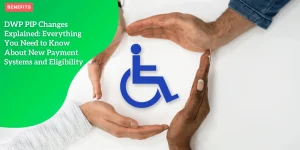Record-Breaking PIP Claims Hit 3.5 Million: What the Year Statistics Reveal
Anúncios
Record-Breaking Numbers and Growth
As of July 2024, Personal Independence Payment (PIP) claims have soared to unprecedented heights, with a record 3.5 million claims in payment.
This historic figure marks a 3% hike from the previous quarter, showcasing steady growth in the program’s reach and impact.
Anúncios
Steady Growth in PIP Claims
This increase is not just a numerical milestone but a testament to the growing demand for support through PIP.
The ongoing rise in claims reflects not only successful claim rates but also the heightened awareness and accessibility of the program.
Anúncios
The increase in claims highlights the tireless efforts of the Department for Work and Pensions (DWP) in handling this uptick while facing complex administrative challenges.
Highest Level of Support
A noteworthy trend within this growth is the rise in claimants receiving the highest level of financial support.
Currently, 37% of claimants are granted the maximum award, up from 36% in the previous quarter.
This slight but meaningful increase implies a better recognition of dire needs, prioritizing substantial support for those with severe disabilities.
It showcases progress in acknowledging and addressing the diverse requirements of PIP claimants.
These record-breaking figures present a snapshot of the evolving landscape for PIP.
They highlight the increasing reliance on the system, the adeptness of DWP in managing this growth, and the focus on providing optimal support for those in need.
Understanding these dynamics helps prepare for the ongoing evaluations and strategic tweaks necessary for further refinement.
Next, we’ll delve into the different outcomes related to new PIP claims and the performance metrics surrounding these processes.
Success Rates and Assessment Outcomes
Understanding the success rates and assessment outcomes for Personal Independence Payment (PIP) claims offers a clear picture of how claims are being managed and awarded.
With a consistent overall success rate for new PIP claims standing at 46%, and an increase to 53% for claims reaching the assessment stage, the PIP system appears effectively structured to support those who meet the eligibility criteria.
Overall Success Rate and Assessment Stage
For new PIP claims made in the latest quarter ending July 2024, the overall success rate was 46%.
This stability indicates a consistent ability of new applicants to meet the demanding criteria for PIP.
When these claims progressed to the assessment stage, the success rate increased to 53%.
This statistic signifies a robust screening process that incrementally supports those most in need.
Award Lengths
Most PIP awards tend to be short-term. Specifically, 79% of awarded claims are granted for a period of 0-2 years.
This preference for shorter-term awards suggests a system designed for regular reassessment to ensure claimants’ conditions are accurately evaluated over time.
While beneficial in maintaining the integrity of support, these frequent reassessments can be stressful and create uncertainty for claimants who must repeatedly justify their need for ongoing assistance.
Implications and Considerations
These trends reflect a balanced approach within the PIP system.
High success rates at the assessment stage show an effective initial screening process.
Yet, the predominance of short-term awards highlights the need for continuous monitoring and reassessment, which can be both a benefit and a burden.
Understanding these dynamics helps claimants set realistic expectations and prepare for periodic reviews.
Moving forward, addressing the complexities of managing ongoing claims, including review and reconsideration outcomes, remains crucial for ensuring effective support for all claimants.
DWP’s Processing Performance
The Department for Work and Pensions (DWP) has demonstrated a notable efficiency in handling new Personal Independence Payment (PIP) claims.
In the latest quarter ending July 2024, there were 210,000 new claim registrations and an impressive 240,000 clearances.
This gap reflects DWP’s capability to not only process all incoming claims but also address previous backlog, ensuring timely decisions for claimants.
Efficient Handling of New Claims
The efficiency of the DWP is highlighted by their ability to manage these claims at a pace faster than the rate of new applications.
The success rates for new claims are consistent, with 46% overall success and 53% at the assessment stage.
The commitment to swiftly managing new claims underscores the department’s dedication to providing prompt support to those in need.
Challenges with Changes of Circumstances
Despite their efficiency in handling new claims, DWP encounters challenges with processing changes of circumstances.
In the same quarter, 33,000 changes were reported, but only 29,000 were cleared.
This discrepancy underscores a processing lag that can impact the timeliness of award adjustments and affect claimants relying on accurate updates to their awarded support.
Decline in Planned Review Decisions
Another issue is the declining number of planned review decisions, showing a 9% reduction compared to the previous year.
Planned reviews are crucial as they determine whether the support level should be continued, increased, or decreased based on the claimant’s current circumstances.
The reduction indicates potential bottlenecks within the review process that warrant attention.
The efficiency demonstrated in new claim processing is commendable; however, the backlog in changes of circumstances and declining review decisions suggest areas that require systemic improvements.
Understanding and addressing these stress points is vital in ensuring that DWP maintains a balance between efficient processing and meeting the evolving needs of claimants.
This awareness will be crucial as the system evolves to better serve all individuals reliant on PIP.
Review and Reconsideration Outcomes
Planned Award Reviews
Planned award reviews play a crucial role in the PIP management system.
They help ensure that the support provided aligns with the claimant’s current situation.
Notably, in the past year, 73% of these reviews resulted in either increased or unchanged awards.
This high percentage illustrates the effectiveness of scheduled reviews in maintaining fair and accurate support for claimants.
It ensures that individuals who continue to meet the criteria or whose needs have grown are adequately supported, offering a necessary safety net.
Changes of Circumstances
Changes of circumstances, such as a shift in health or living conditions, can significantly affect an individual’s PIP eligibility or the amount they receive.
The system appears responsive in this regard, with 85% of reported changes resulting in either increased or unchanged awards.
This responsiveness reassures claimants that their evolving needs are taken into account, and in most cases, these changes work to their benefit.
It helps maintain a level of support that reflects their current situation, allowing for more personalized care.
Mandatory Reconsiderations
For those dissatisfied with their initial PIP decision, mandatory reconsiderations provide an essential opportunity for review.
With 34% of these reconsiderations leading to award changes, this step represents a meaningful route for claimants to contest and potentially improve their support.
The fact that one-third of appeals result in adjustments reflects both the room for improvement in initial assessments and the system’s willingness to correct itself.
It emphasizes the commitment to fairness and due process within the PIP framework.
Integrative Roles
Each component—planned reviews, changes of circumstances, and mandatory reconsiderations—works integratively to uphold the integrity and fairness of the PIP system.
They ensure that claimants’ awards are reflective of their current needs and circumstances, fostering a dynamic and responsive support structure.
Together, these processes underscore the Department for Work and Pensions’ (DWP) ongoing efforts to adapt and refine the PIP system.
They help balance rigorous assessment with compassionate support, a critical combination in an ever-evolving social support landscape.
Understanding these elements is vital for grasping how the system remains equitable and responsive, adapting to both individual and systemic changes.
Special Categories and Transitions
The recent statistics for Personal Independence Payment (PIP) claims reveal critical insights into the system’s treatment of special cases and transitions.
These numbers provide a window into how effectively the PIP framework manages unique scenarios like end-of-life claims and the challenging shift from Disability Living Allowance (DLA) to PIP.
Special Rules for End of Life Claims
A standout figure is the 98% success rate for claims processed under the Special Rules for End of Life (SREL) category.
This high approval rate underscores the Department for Work and Pensions’ (DWP) commitment to providing timely support for individuals in critical, life-limiting conditions.
The near-automatic approval reflects a compassionate approach, ensuring these claimants receive the necessary assistance without undue delay.
By focusing on expediency and minimizing procedural hurdles, the DWP aims to alleviate some of the pressures faced by individuals and families during such challenging times.
DLA to PIP Reassessments
The transition from DLA to PIP has been notably successful in some aspects, with 70% of reassessments resulting in continued support for claimants.
This high success rate indicates that a majority of individuals moving from DLA to PIP still meet the necessary criteria, ensuring they do not experience significant disruption in their financial support.
This continuity is crucial for maintaining the quality of life for those with long-term needs.
Ongoing Transition Challenges
Despite the success rate, the process of transitioning from DLA to PIP continues to face significant hurdles.
The sheer volume of reassessments and the complexities involved in shifting from one support framework to another have posed ongoing challenges.
These include administrative bottlenecks, delays in clearances, and the inherent stress on claimants as they navigate the reassessment process.
Addressing these issues requires continued improvement in DWP’s procedures to make transitions smoother and more efficient.
The detailed statistics and insights from these categories highlight the complexities and the human-centric focus of the PIP system.
By understanding the successes and challenges in these areas, stakeholders can better approach future improvements in the handling of special cases and transitions within the PIP framework.
This nuanced understanding fosters a responsive system aimed at meeting the evolving needs of its claimants.







